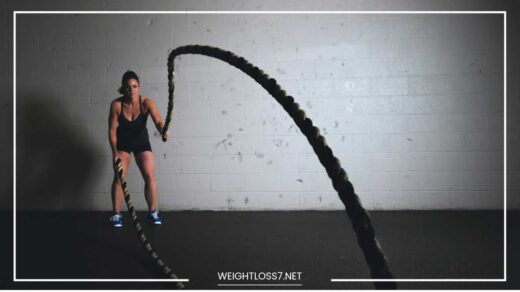Weight Loss Workout Plan for Beginners

Weight Loss Workout Plan
Weight Loss Workout Plan for Beginners: Kickstart Your Journey to a a Healthier You
Taking that first step towards weight loss can feel like leaping off a cliff – exhilarating yet terrifying. You’re bombarded with conflicting workout plans, endless fitness challenges, and enough diet advice to fill a library. But worry not, beginner adventurer!
This guide is designed to be your trusty sherpa, leading you with a simple, effective workout plan to jumpstart your journey to a healthier, happier you.
Why Exercise Matters for Weight Loss: The Science Behind the Sweat
Think of exercise as your personal calorie-burning furnace. It directly burns calories during the activity, but its benefits extend far beyond that initial sweat session. Here’s a deeper dive into how exercise fuels your weight loss journey:
-
The Calorie-Burning Powerhouse: Cardio exercises like brisk walking, jogging, or swimming are the frontline soldiers in the war against unwanted pounds. They directly burn calories during the activity, creating an immediate calorie deficit. Strength training, on the other hand, builds muscle, which acts like a metabolic afterburner. Even at rest, muscle burns more calories than fat, giving your weight loss efforts a long-term boost.
-
Metabolic Makeover: Your metabolism is the rate at which your body burns calories for energy. Exercise, particularly high-intensity interval training (HIIT), can elevate your metabolic rate for hours after your workout, leading to increased calorie burning even when you’re catching your breath on the couch (although catching your breath on the couch after a HIIT session might not be an option!).
-
Appetite Regulation: Exercise plays a fascinating role in regulating hormones that control hunger and fullness. Regular physical activity can help suppress your appetite, making you feel fuller for longer and potentially leading to reduced calorie intake throughout the day. Imagine saying goodbye to those afternoon snack attacks!
-
Energy Levels on High: Ever feel sluggish and drained? Regular exercise improves your body’s efficiency in using oxygen, leading to increased stamina and energy levels. You’ll have more pep in your step to tackle your day and conquer those workouts!
Building a Sustainable Routine: Making Exercise a Habit You Love
The key to successful weight loss isn’t just about burning calories; it’s about creating a workout routine you can stick with in the long run. Here are some battle-tested tips for building a sustainable routine that won’t leave you feeling like you’re climbing Mount Everest in flip-flops:
-
Start Slow and Steady Wins the Race: Don’t try to go from couch potato to gym rat overnight. Begin with shorter sessions (think 20-30 minutes) that feel manageable. Gradually increase the duration and intensity as your fitness improves. Remember, slow and steady progress is key to avoiding burnout and injuries.
-
Listen to Your Body – It’s Your Trusted Guide: Your body is like a wise old friend – it will tell you when it needs a break. Pay attention to aches, pains, and fatigue. Take rest days when needed, and don’t push yourself to the point of pain. Pushing through moderate discomfort is okay, but pain is a red flag.
-
Find Activities You Can Actually Enjoy: Who says exercise has to be a chore? Explore different activities like dancing, swimming, group fitness classes, or even rock climbing (if you’re feeling adventurous!). Finding something you genuinely enjoy will make you look forward to your workouts, not dread them.
-
Inject Some Fun into Your Fitness: Put on some upbeat music you love, workout with a friend for some social support, or try a new activity to keep things interesting. The more enjoyable your workouts are, the more likely you are to stick with them.
-
Set SMART Goals: Specific, Measurable, Achievable, Relevant, and Time-Bound: Setting realistic and achievable goals will keep you motivated. Celebrate your progress, no matter how small, to keep yourself on track. Reaching a weight loss goal is fantastic, but even small victories like completing a longer workout or mastering a new exercise are worth celebrating!
The Beginner Weight Loss Workout Plan: Your Personalized Roadmap to Success
This sample workout plan is designed to be your personalized roadmap to weight loss success. It combines cardio and strength training for a well-rounded approach, and is specifically designed for beginners.
It’s recommended to do this plan 3-4 days a week with rest days in between. Remember, consistency is key! Here’s a breakdown of your weekly fitness adventure:
Warm-up (5-10 minutes):
- Light Cardio: This gets your blood flowing and prepares your muscles for exercise. Brisk walking, jogging in place, or jumping jacks are all great options.
- Dynamic Stretches: These stretches move your joints through their full range of motion, improving flexibility and reducing the risk of injury. Arm circles, leg swings lunges with torso twists, and high knees are all good dynamic stretches to incorporate.
Cardio (20-30 minutes):
This section is where you really get your heart rate up and burn some serious calories. Here’s a breakdown for each day:
Day 1 & 3: Brisk Walking (30 minutes): Walking is a fantastic low-impact exercise that’s easy on the joints and perfect for beginners. Explore different walking routes to keep things interesting, like a park, a nature trail, or even a scenic neighborhood. You can gradually increase the intensity by walking at a faster pace or finding routes with inclines.
Day 2 & 4: Choose One Activity – Swimming (30 minutes): Swimming is an excellent full-body workout that is gentle on your joints. It engages almost all major muscle groups while providing a refreshing cool-down on hot days. If you’re new to swimming, start by focusing on basic strokes like the freestyle or breaststroke.
Cycling (30 minutes): Cycling is a low-impact cardio option that strengthens your legs, core, and cardiovascular system. You can cycle outdoors or use a stationary bike at home. Start with a comfortable pace and resistance level, gradually increasing as your fitness improves.
Elliptical Trainer (30 minutes): The elliptical trainer is a popular cardio machine that simulates stair climbing or running without the impact. It’s a great option for those with joint issues or who prefer a low-impact workout.
Strength Training (20-30 minutes):
This section focuses on building muscle, which as mentioned before, is a calorie-burning machine even at rest. This plan utilizes bodyweight exercises and light weights (dumbbells or resistance bands) to target all major muscle groups. Perform 2-3 sets of 10-12 repetitions of each exercise with good form. Rest for 30-60 seconds between sets.
Here’s a breakdown of the strength training routine:
Day 1 & 3 (Lower Body):
- Squats: This exercise works your quads, hamstrings, and glutes. Stand with your feet shoulder-width apart, toes slightly outward. Lower your body as if sitting in a chair, keeping your back straight and core engaged. Push through your heels to return to starting position.
- Lunges: This exercise targets your quads, hamstrings, and glutes. Step forward with one leg, lowering your body until both knees are bent at 90-degree angles. Push through your front heel to return to starting position. Repeat on the other leg.
- Wall Sits: Strengthens your quads and core. Simply lean your back against a wall and slide down until your thighs are parallel to the floor. Hold this position for as long as you can comfortably manage.
- Calf Raises: This exercise targets your calves for improved leg definition. Stand on the balls of your feet, then slowly lower your heels down as far as you can comfortably go. Raise back up onto your toes.
Day 2 & 4 (Upper Body):
- Push-ups: This classic exercise works your chest, triceps, and shoulders. Start in a high plank position with your hands shoulder-width apart. Lower your chest towards the floor, keeping your core engaged and body in a straight line. Modified push-ups can be done on your knees if needed.
- Rows (using a chair or resistance band): Target your back muscles with this exercise. Sit on a chair or stand with your feet shoulder-width apart and hold a dumbbell or resistance band in each hand. Row your elbows back as if pulling the weight towards your chest, squeezing your shoulder blades together.
- Overhead press (using dumbbells or bodyweight): Strengthens your shoulders. Stand with your feet shoulder-width apart and hold a dumbbell in each hand at shoulder level. Press the weights directly overhead until your arms are straight. You can use bodyweight for this exercise by extending your arms straight overhead with palms facing forward.
- Bicep Curls (using dumbbells or resistance bands): This exercise works your biceps. Stand with your feet shoulder-width apart and hold a dumbbell or resistance band in each hand at your sides. Curl the weight up towards your shoulders, squeezing your bicep muscles at the top.
Cool-down (5-10 minutes):
Don’t underestimate the importance of a proper cool-down! It helps your body gradually return to its resting state and reduces muscle soreness.
- Static Stretches: Hold each stretch for 15-30 seconds for major muscle groups like your quads, hamstrings, calves, chest, back, and shoulders. Here are some examples:
- Quad Stretch: Stand tall and grab one foot behind your calf, gently pulling your heel towards your glutes. Hold for 15-30 seconds and repeat on the other leg.
- Hamstring Stretch: Sit on the floor with your legs extended in front of you. Reach for your toes, keeping your back straight. If you can’t reach your toes, hold onto your hamstrings or calves for a modified stretch. Hold for 15-30 seconds.
- Calf Stretch: Stand with your feet shoulder-width apart and lean forward, placing your hands on a wall or other sturdy object. Keep one leg straight behind you and the other foot flat on the floor. Push your heels down towards the floor and hold for 15-30 seconds. Repeat on the other leg.
- Chest Stretch: Stand in a doorway and place your forearms on either side of the doorframe. Gently lean forward, stretching your chest muscles. Hold for 15-30 seconds.
Progression and Modifications: Getting Stronger Without Getting Injured
As you become more comfortable with the exercises and your fitness improves, you can gradually increase the difficulty of your workouts to keep challenging yourself and maximizing your results. Here are some ways to progress:
- Increase the number of sets or repetitions: Once you can comfortably perform 3 sets of 10-12 repetitions with good form, try increasing the number of sets to 4 or the number of repetitions to 12-15.
- Shorten your rest periods: As your strength improves, you can decrease the amount of rest you take between sets. This will keep your heart rate up and burn more calories during your workout. Start with a 30-second rest period and gradually decrease it to 15-20 seconds.
- Use heavier weights or resistance bands: As bodyweight exercises become easier, you can challenge yourself further by using dumbbells or resistance bands. Start with a weight that allows you to maintain good form throughout the entire exercise.
- Increase the duration of your cardio sessions: Once you can comfortably complete 30 minutes of cardio, try increasing the duration to 40 or 45 minutes. You can also add intensity intervals to your cardio routine. For example, alternate between brisk walking and jogging for short periods.
Remember: It’s important to modify exercises if you have any limitations or injuries. Don’t hesitate to consult a doctor or certified personal trainer for personalized guidance on modifying exercises or creating a workout plan specific to your needs.
Diet and Nutrition for Weight Loss: Fueling Your Fitness Journey
A healthy diet is just as important as exercise for weight loss. Here are some key dietary principles to incorporate into your lifestyle:
- Focus on Whole Foods: Fill your plate with unprocessed, whole foods like fruits, vegetables, whole grains, and lean protein sources. These foods are packed with essential nutrients that will keep you feeling energized and satisfied.
- Mindful Portion Control: It’s not just about what you eat, but also how much you eat. Use smaller plates, pay attention to your hunger and fullness cues, and avoid mindless snacking.
- Limit Processed Foods: Processed foods are often loaded with unhealthy fats, added sugars, and sodium, which can hinder your weight loss efforts.
- Stay Hydrated: Water is essential for overall health and can also aid in weight loss. Aim to drink plenty of water throughout the day.
- Don’t Deprive Yourself: Restrictive diets are often unsustainable and can lead to unhealthy relationships with food. Allow yourself occasional treats in moderation, but focus on making healthy choices most of the time.
Building a Sustainable Lifestyle: Beyond the Workout
Weight loss is a journey, not a destination. Here are some additional tips to create a sustainable and healthy lifestyle that goes beyond just your workouts:
- Get Enough Sleep: Aim for 7-8 hours of sleep each night. Adequate sleep regulates hormones that influence appetite and metabolism, making it easier to maintain a healthy weight.
- Manage Stress: Chronic stress can lead to weight gain. Find healthy ways to manage stress, such as yoga, meditation, or spending time in nature.
- Find an Accountability Partner: Having a friend or family member to join you on your weight loss journey can provide motivation and support.
- Celebrate Your Non-Scale Victories: Don’t just focus on the number on the scale. Celebrate your non-scale victories, such as having more energy, feeling stronger, or fitting into your clothes better.
- Make it a Lifestyle Change, Not a Diet: Think of your healthy habits as a lifestyle change, not just a temporary diet. This will increase your chances of long-term success and overall well-being.
Beyond the Basics: Exploring Additional Activities
As you progress on your weight loss journey, you might want to explore different activities to keep your workouts interesting and prevent plateaus. Here are some ideas:
- Group Fitness Classes: Group fitness classes offer a fun and social way to get your workout in. There are a variety of classes available, from high-intensity interval training (HIIT) to Zumba to yoga.
- Team Sports: Joining a sports team can be a great way to get exercise and socialize. Consider activities like basketball, volleyball, or soccer.
- Hiking or Biking: Explore the outdoors and get some exercise with hiking or biking. These activities are a great way to burn calories and enjoy nature.
- Dance Classes: Dancing is a fun and energetic way to get your heart rate up and burn calories. There are many different styles of dance to choose from, so you can find something you enjoy.
Remember: Consistency is key! The most important thing is to find activities you enjoy and can stick with in the long run.
Final Word: Your Journey to a Healthier You Begins Now
Taking that first step towards a healthier you is a fantastic decision. This guide provides you with the tools and knowledge to kickstart your weight loss journey with a simple and effective workout plan. Remember, weight loss is a marathon, not a sprint. Be patient, celebrate your progress, and most importantly, have fun on your fitness journey!

















